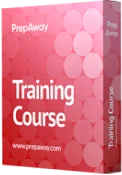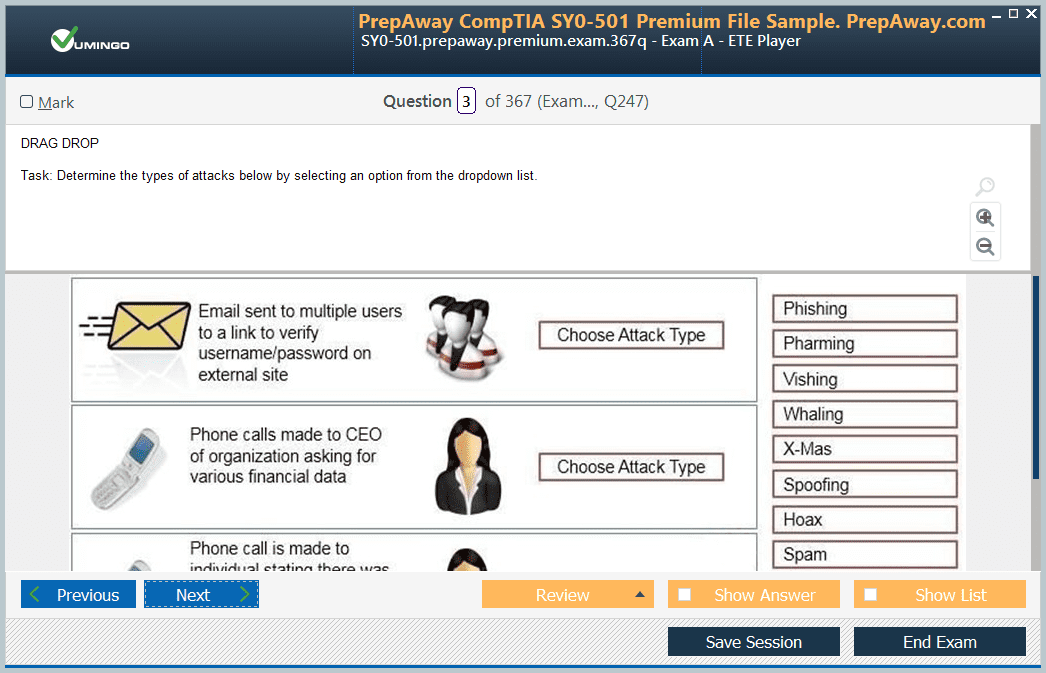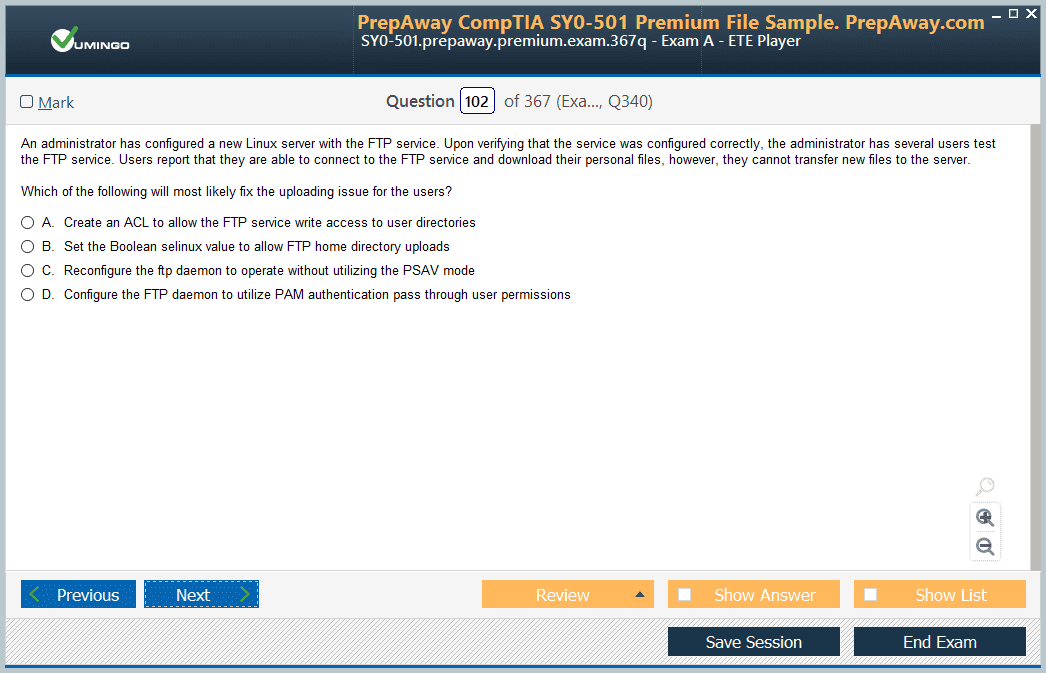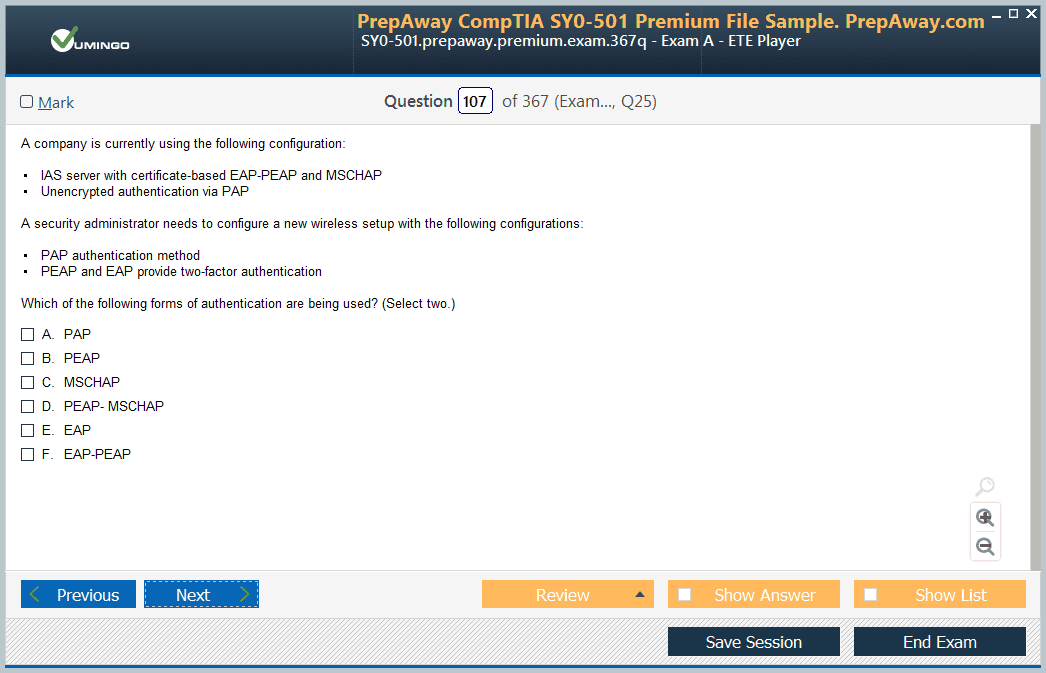- Home
- Microsoft Certifications
- SC-900 Microsoft Security, Compliance, and Identity Fundamentals Dumps
Pass Microsoft Security SC-900 Exam in First Attempt Guaranteed!
Get 100% Latest Exam Questions, Accurate & Verified Answers to Pass the Actual Exam!
30 Days Free Updates, Instant Download!


SC-900 Premium Bundle
- Premium File 226 Questions & Answers. Last update: Dec 18, 2025
- Training Course 147 Video Lectures
- Study Guide 413 Pages
Last Week Results!

Includes question types found on the actual exam such as drag and drop, simulation, type-in and fill-in-the-blank.

Based on real-life scenarios similar to those encountered in the exam, allowing you to learn by working with real equipment.

Developed by IT experts who have passed the exam in the past. Covers in-depth knowledge required for exam preparation.
All Microsoft Security SC-900 certification exam dumps, study guide, training courses are Prepared by industry experts. PrepAway's ETE files povide the SC-900 Microsoft Security, Compliance, and Identity Fundamentals practice test questions and answers & exam dumps, study guide and training courses help you study and pass hassle-free!
Begin with SC-900: The First Step to Understanding Microsoft Security
As organizations grow increasingly reliant on digital infrastructure, the demand for cybersecurity professionals continues to rise. With this growing demand comes a wide array of certifications tailored to different levels of expertise, platforms, and career goals. For beginners or professionals making a pivot into cybersecurity, two certifications frequently come into focus: CompTIA Security+ and Microsoft’s SC-900. While both are considered entry-level or foundational, their scopes, intentions, and target audiences differ significantly.
Understanding the nature of these certifications—what they cover, whom they're for, and how they position candidates for career growth—is essential for making an informed choice.
The Evolution and Relevance of Security Certifications
Cybersecurity is no longer a specialized niche but a core business function. Regulatory compliance, cloud transformation, and increasing sophistication of cyber threats have made it crucial for all tech professionals to understand fundamental security principles. Certifications provide a structured path to gain and validate this understanding.
Over the years, professional certificates have evolved to address both theoretical knowledge and practical expertise. Older frameworks focused on hardware and on-premises security, while newer ones encompass cloud-based, hybrid, and identity-centric models. Security+ and SC-900 represent two important perspectives on these trends.
Security+ originated in a time when basic networking and local system security were top priorities. Its design was rooted in broad applicability across different vendor environments. On the other hand, SC-900 is a reflection of the new cloud-first era, where integrated services, identity protection, and compliance automation within large ecosystems such as Microsoft Azure are increasingly central.
CompTIA Security+: A Vendor-Neutral Perspective
CompTIA Security+ is often cited as a baseline certification for cybersecurity professionals. Developed by a non-profit trade association, it is designed to provide vendor-agnostic knowledge, allowing professionals to work across diverse IT environments. Security+ teaches how to assess the security posture of an enterprise, monitor and secure hybrid environments, and implement appropriate security solutions.
The value of Security+ lies in its broad scope. It covers topics such as access control, incident response, governance, risk management, and cryptography. Because of its comprehensive nature, it is often included in job postings for roles such as security analyst, network administrator, and compliance specialist.
Importantly, Security+ aligns with government and defense contracting requirements, often serving as a minimum requirement for professionals handling sensitive data or systems.
Microsoft SC-900: The Cloud-Era Fundamentals
SC-900 is a certification developed by Microsoft to help individuals understand the core principles of identity, security, and compliance in the context of Microsoft’s cloud services. It’s tailored for professionals working within Microsoft-centric environments, including Azure Active Directory, Microsoft Defender, and compliance tools within Microsoft 365.
Unlike Security+, SC-900 is highly specific. It assumes familiarity with Microsoft cloud services and teaches how to apply Microsoft’s security and compliance capabilities to protect cloud-based assets. Candidates are expected to understand not only theoretical principles but also how Microsoft solutions implement those principles.
The SC-900 certification can be particularly useful for professionals in organizations undergoing digital transformation projects, especially those migrating to or managing cloud-native infrastructure.
Technical Focus Areas: A Comparative Lens
Security+ covers a wide array of cybersecurity disciplines. These include secure network architecture, identity and access control mechanisms, endpoint protection, vulnerability management, and cryptographic implementations. The topics are framed in a way that applies across multiple technologies, systems, and platforms. For example, a lesson on firewalls isn’t tied to a specific product but rather to the conceptual role and configuration of firewalls in network security.
SC-900 focuses less on theoretical concepts and more on how Microsoft tools operationalize security strategies. For instance, instead of discussing multifactor authentication in a general sense, it explores how to configure and enforce it using Microsoft Entra ID (formerly Azure AD). It also addresses how Microsoft Purview manages information governance and how Microsoft Sentinel fits into a security operations workflow.
Because of these differences, SC-900 often appeals more to business analysts, project managers, and IT generalists working in Microsoft-based organizations, while Security+ is more common among those pursuing hands-on security roles.
Practical Applications and Job Alignment
Professionals who earn Security+ are often qualified for entry-level security positions. These roles might include monitoring security alerts, conducting initial incident analysis, or enforcing company-wide security policies. Security+ demonstrates that the holder can implement and manage security controls, perform threat analysis, and respond to incidents.
By contrast, SC-900 is usually seen as a preparatory step toward more advanced Microsoft certifications. It doesn't directly qualify an individual for a hands-on security job but signals that the person understands the security and compliance features of Microsoft products. This can be especially relevant in industries such as healthcare or finance, where regulatory compliance plays a significant role.
SC-900 holders often move into roles that involve policy enforcement, administrative configuration of cloud tools, or advisory roles supporting cloud migration or compliance efforts.
Preparation and Study Considerations
The pathway to preparing for either certification varies significantly. Security+ generally requires a more extended study period, often between 30 to 60 days, depending on prior experience. Its breadth and technical depth demand familiarity with networking principles, operating systems, risk frameworks, and security tools.
Recommended prior knowledge includes basic IT concepts, such as those covered in CompTIA A+ and Network+. Candidates who have worked in IT support, helpdesk, or system administration tend to have a smoother experience.
SC-900, on the other hand, is considered more accessible in terms of study duration and complexity. Many candidates prepare for the exam in just a few days or over a single weekend, especially if they already work with Microsoft platforms. The exam is structured to be concept-focused and offers a lighter technical load.
However, this doesn’t mean SC-900 is easy for everyone. Those without hands-on exposure to Microsoft cloud services may need to spend time learning about its interfaces, architecture, and management portals to perform well on the exam.
The Role of Practical Experience
Certifications are most valuable when paired with practical experience. Security+ benefits individuals with a background in IT operations or network administration. The exam includes scenario-based questions requiring candidates to understand real-world security implications and apply decision-making strategies.
SC-900 is more conceptual but still assumes some exposure to Microsoft's cloud ecosystem. Practical experience with Microsoft Entra ID, Microsoft Defender, or compliance portals allows candidates to contextualize exam questions and better appreciate the certification’s goals.
Aspiring professionals should consider labs or sandbox environments to simulate real-world scenarios. There are also platforms that allow learners to interact with virtual systems to practice setting up firewalls, managing identities, or responding to simulated incidents.
Career Progression and Strategic Positioning
Both certifications can be part of a broader career development strategy. Security+ is often the first of many cybersecurity certifications. Professionals may later pursue specialized credentials in ethical hacking, penetration testing, cloud security, or incident response.
Security+ also opens pathways to certifications from other organizations focused on specific areas like governance, risk management, or digital forensics. It is well-suited for individuals aiming to specialize in security architecture, network defense, or cyber threat intelligence.
SC-900 is part of Microsoft’s certification track and can be followed by more role-specific exams like SC-200 (Security Operations Analyst), SC-300 (Identity and Access Administrator), or SC-400 (Information Protection Administrator). These certifications allow candidates to delve deeper into specific tools and functions within Microsoft environments.
Choosing between these tracks depends on the professional’s career goals, industry focus, and the technology stack they expect to work with.
ore topics covered in SC-900 certification
The SC-900 certification centers around a defined set of knowledge areas related to security, compliance, and identity within Microsoft's cloud ecosystem. The core areas include the basic concepts of security, Microsoft Entra ID (formerly Azure Active Directory), Microsoft compliance solutions, and Microsoft security capabilities.
Candidates are introduced to identity principles such as authentication, authorization, and identity protection. The certification also highlights how Microsoft solutions handle access control, conditional access policies, role-based access controls, and identity governance. These concepts are framed in real-world scenarios, such as preventing unauthorized access in hybrid environments or managing external identities in enterprise collaboration settings.
The compliance section examines how Microsoft tools help organizations meet regulatory and legal obligations. This includes data classification, information governance, risk management, and audit readiness. Microsoft compliance manager, insider risk management, and eDiscovery features are explored to provide a broad understanding of compliance monitoring and response strategies.
The security portion includes an overview of Microsoft Defender, threat protection services, cloud security posture management, and the role of Microsoft Sentinel in detecting and responding to security incidents. While the SC-900 exam does not require deep technical implementation knowledge, it emphasizes conceptual fluency and awareness of how these tools are integrated across Microsoft’s ecosystem.
Technical contrast with vendor-neutral certifications
While the SC-900 exam explores tools specific to a single platform, certifications like Security+ take a technology-agnostic approach. Security+ covers multiple layers of cybersecurity, such as physical security, endpoint protection, secure application development, and network protocols, with no emphasis on a single vendor.
This difference creates contrasting outcomes. SC-900 equips individuals with an understanding of Microsoft’s platform and how its tools interconnect. For example, candidates learn how Microsoft Purview supports data lifecycle management and how Microsoft Defender correlates threats across endpoints, identities, and applications.
Security+, by comparison, teaches universal principles such as symmetric and asymmetric encryption, zero trust architecture, threat intelligence lifecycle, and network hardening strategies. These skills apply across different cloud providers and legacy systems, offering flexibility for professionals who may work in mixed environments.
SC-900’s technical scope is more constrained but also more precise. It enables individuals to gain clarity on a very specific set of tools that are in high demand in organizations heavily reliant on Microsoft cloud solutions.
Enterprise relevance and real-world application of SC-900
One of the key advantages of the SC-900 certification is its alignment with how modern enterprises operate within cloud platforms. As more companies migrate to Microsoft 365 and Azure, the need for professionals who understand Microsoft’s approach to securing and governing data becomes more pronounced.
SC-900 provides a roadmap for individuals involved in planning or overseeing cloud security strategies. For example, a compliance analyst may use the knowledge from SC-900 to help configure Microsoft’s information protection labels, while a technical project manager might use their understanding to coordinate cloud migration efforts in alignment with organizational security policies.
Even though the certification is not deeply technical, it offers a meaningful layer of insight for decision-makers who need to evaluate and deploy Microsoft solutions effectively. It builds confidence among business users, consultants, and IT generalists tasked with supporting cloud adoption or managing cross-functional risk assessments.
SC-900 as a steppingstone to advanced certifications
While SC-900 does not certify deep technical expertise, it plays a strategic role in the broader certification journey. It acts as a foundation for progressing toward more focused, role-based credentials within the Microsoft certification track.
Professionals who complete SC-900 often move toward specialized certifications in areas like identity administration, compliance management, or security operations. Each of these certifications requires a greater depth of knowledge and hands-on experience. SC-900 prepares candidates for these by establishing a conceptual understanding of the tools and terminologies they will encounter in more advanced exams.
The modular nature of Microsoft’s certification system allows learners to develop competence incrementally. SC-900 is often used as a first exposure point for individuals unsure about which area of security they want to pursue. Once foundational confidence is established, learners can transition to more technical content with better context and alignment.
Challenges in preparing for SC-900 and how to overcome them
Although SC-900 is considered an introductory certification, it presents challenges for individuals without experience in Microsoft environments. Many questions rely on understanding how various services interconnect within Microsoft’s cloud offerings. A lack of exposure to portals such as Microsoft Entra admin center, compliance center, or Microsoft 365 admin center can make it difficult to fully grasp the scenarios presented in the exam.
Candidates can overcome these obstacles by engaging in self-paced labs or guided simulations. Exploring trial environments and practicing with sample tasks—such as setting up conditional access policies or classifying data using Microsoft information protection labels—can deepen understanding.
Another common hurdle is the terminology. Microsoft uses specific branding and nomenclature for its services, which may confuse those familiar with general security concepts but unfamiliar with Microsoft’s ecosystem. Paying attention to terminology and the way services are grouped or integrated helps prepare for the nuance often found in SC-900 questions.
Time investment is typically moderate. Professionals with previous exposure to Microsoft cloud services may be able to prepare in under a week, while others may require up to two weeks of focused study to reach exam readiness.
SC-900 and job readiness
One of the misconceptions about foundational certifications like SC-900 is that they are sufficient to qualify someone for a technical security role. While SC-900 demonstrates an understanding of Microsoft’s security and compliance capabilities, it is not designed to validate implementation or troubleshooting skills.
That said, it plays an important role in non-technical job functions. It can support career advancement for individuals working in governance, risk, and compliance roles or those in administrative positions responsible for enforcing organizational policies.
It also supports roles that involve stakeholder communication. Project leads, business analysts, and consultants who understand how security and compliance are handled in cloud environments can bridge the gap between technical teams and executive leadership. SC-900 provides language, frameworks, and perspectives that help professionals operate confidently in these intermediary positions.
For those aiming to work in technical roles, SC-900 should be considered a steppingstone. It builds context, but not credentials for hands-on responsibilities such as threat hunting, forensic analysis, or firewall configuration.
Organizational value of SC-900 certification
Organizations benefit when team members understand the security and compliance landscape of the platforms they rely on. SC-900-certified employees contribute to better decision-making during audits, security reviews, and policy changes.
Because it emphasizes integration, SC-900 enables cross-team collaboration. A human resources professional implementing access control for internal documents can work more effectively with the IT team when they understand Microsoft information protection. Similarly, legal or compliance departments gain value when their staff are able to navigate the compliance manager dashboard and interpret results in context.
For organizations undergoing digital transformation, this certification can play a role in reducing friction and ensuring consistent alignment between technical and non-technical teams. It helps everyone speak the same language, reducing miscommunication and improving the efficiency of projects related to cloud migration or data governance.
Future trends and relevance of SC-900
As the role of cloud-native platforms in enterprise security continues to expand, certifications like SC-900 are likely to gain greater prominence. The growing complexity of hybrid work, remote collaboration, and decentralized data requires professionals who can understand and manage these challenges using integrated tools.
SC-900 positions individuals to operate effectively in this reality. By focusing on Microsoft’s interconnected suite of solutions, it ensures professionals are prepared for scenarios that are increasingly common in business environments—such as data classification across distributed teams or identity access across internal and external networks.
Its focus on compliance also matches the rising importance of regulatory alignment. With data privacy regulations becoming stricter across regions and industries, organizations are more interested than ever in ensuring that staff understand how to meet these requirements using their existing tools.
SC-900 is not a deep technical certification, but it reflects a trend toward security awareness and platform fluency across business functions. As the line between IT and business operations continues to blur, certifications like this one will help organizations navigate the complexity of digital enterprise security.
How Certifications Affect Hiring Expectations
As cybersecurity threats evolve and organizations expand their digital infrastructure, hiring managers seek candidates who not only understand security concepts but also show familiarity with specific platforms. The SC-900 certification addresses this demand within Microsoft-based environments, offering a credential that proves awareness of integrated cloud security, identity management, and compliance.
Unlike high-level technical certifications, SC-900 is not aimed at proving hands-on expertise. Instead, it serves as a signal that a candidate can speak the language of security in a Microsoft ecosystem. This can influence hiring decisions in departments that bridge technology with business functions, such as governance teams, security policy enforcement groups, and risk management offices.
For technical positions, SC-900 is rarely a standalone qualifier. However, when paired with relevant experience or other certifications, it can boost a candidate’s profile by demonstrating their familiarity with Microsoft’s compliance model and cloud security structure.
Why Organizations Value Foundational Certifications
Organizations benefit from employees who have a shared understanding of the frameworks and services they use. In Microsoft-centric environments, SC-900 plays this role by providing entry-level staff with a common reference point for tools and practices tied to identity protection, threat detection, and data governance.
In many cases, companies use SC-900 as part of onboarding or professional development programs for non-technical teams. Business analysts, auditors, legal advisors, and HR professionals can all improve their operational effectiveness by understanding how Microsoft tools enforce policy and protect sensitive data.
This shared baseline improves communication across departments. A team member who has completed the SC-900 exam is more likely to align with the goals of security architects and administrators, reducing the friction that often arises when policy must be translated into implementation.
How SC-900 Influences Internal Training Programs
SC-900 has also been adopted by organizations to upskill existing employees who may not come from a traditional technical background. Rather than focusing on configuring systems or writing scripts, the certification teaches principles that apply to strategic decision-making and system governance.
Internal training teams can use SC-900 content as a curriculum for workshops or learning pathways focused on compliance and security awareness. This ensures that staff involved in operations, procurement, or data handling know how to contribute to the security posture of the company.
When used as part of a layered training program, SC-900 helps organizations build a security-first mindset. This mindset is crucial when implementing zero trust models or preparing for audits, where awareness and consistent policy execution are essential.
Job Roles That Align With SC-900 Certification
The job roles most aligned with SC-900 certification tend to be hybrid or advisory in nature. Examples include cloud project coordinators, compliance analysts, customer success managers for cloud products, and junior identity and access management analysts.
These roles do not always involve direct system administration but often require close collaboration with those who do. Individuals in these roles may evaluate policy enforcement, draft data protection strategies, manage vendor compliance, or assist in incident communication during security events.
SC-900 provides a lens through which these professionals can interpret and interact with Microsoft’s security tools. It offers them confidence when joining cross-functional meetings or supporting decisions about security technology implementation.
SC-900’s Role In Cross-Departmental Collaboration
Effective cybersecurity depends on the cooperation of multiple departments. It is no longer the sole responsibility of IT. Legal teams review policy language, finance teams manage risk exposure, and operations departments handle procedural enforcement. SC-900 prepares non-security teams to engage meaningfully with technical discussions about identity controls, policy automation, and security governance.
By teaching concepts like conditional access, data loss prevention, and role-based access control in the context of Microsoft platforms, SC-900 provides a shared understanding across teams. This reduces the communication gap between compliance and engineering or between risk management and identity administrators.
In many enterprises, initiatives such as hybrid workplace management or remote access policy design benefit from having multiple SC-900-certified contributors. These individuals can articulate the business needs while ensuring alignment with platform capabilities and security principles.
The Perception Of SC-900 Compared To Technical Certifications
Employers typically categorize SC-900 differently from more technical certifications such as Security+, CySA+, or cloud-specific administrator exams. SC-900 is often viewed as awareness-level or context-focused, meaning it demonstrates knowledge of how things fit together rather than how to build or fix them.
This distinction is important when mapping out a certification path. Candidates should understand that SC-900 enhances career potential in roles involving analysis, governance, coordination, or support, but it may need to be followed by technical certifications if the goal is to enter hands-on security operations or engineering roles.
The strength of SC-900 lies in its clarity and targeted scope. It tells an employer that the candidate understands Microsoft’s approach to security, compliance, and identity management. This can be particularly useful in cloud adoption projects, digital workplace strategy teams, or audit readiness task forces.
Long-Term Impact Of Foundational Certifications
For long-term career growth, SC-900 helps build foundational literacy in cloud security and regulatory concepts. While it may not lead directly to a high-level security engineer role, it lays the groundwork for further specialization.
Professionals who begin with SC-900 often pursue deeper certifications later, either within the Microsoft track or through more generalized paths. This progression creates a well-rounded skill set that blends policy fluency with technical depth.
The long-term value of SC-900 also depends on the individual’s role and career direction. Someone working in enterprise compliance, digital risk management, or customer advisory roles may continue to use the core principles learned in SC-900 even as they move into more strategic positions.
Integrating SC-900 Into Organizational Goals
Companies that want to strengthen their security culture often adopt SC-900 as part of a larger initiative. This might include promoting cloud literacy, preparing for security audits, or building internal consulting teams. SC-900 becomes part of a toolkit that supports communication, planning, and policy execution.
Organizations that embed certifications into their talent development plans not only improve individual capabilities but also support strategic goals. When multiple departments share a common understanding of security principles, the organization becomes more agile and more resilient to disruption.
SC-900 fits well into such programs because it is approachable, relevant to modern business operations, and tied to tools that many organizations already use. This makes it a low-barrier, high-impact certification that can be scaled across teams.
Choosing The Right Certification Path For Your Career
Selecting the appropriate certification at the beginning of a cybersecurity journey can be overwhelming, especially with the wide variety of credentials available. SC-900 offers a clear path for individuals who are either new to the field or are transitioning from a non-technical background into roles that support cloud-based environments. Unlike certifications that require deep system administration skills, SC-900 focuses on understanding security and compliance concepts within Microsoft platforms.
When considering your path, it's important to align certifications with your career goals. If you aim to work in a Microsoft-centric organization, or in a role that bridges technology and compliance, SC-900 is a strategic first step. It opens opportunities in roles that require knowledge of cloud security frameworks but may not involve direct technical implementation. If your career goal includes becoming a cloud security engineer or a penetration tester, SC-900 may serve as a supplement to more technical certifications rather than a core requirement.
This makes SC-900 valuable for professionals who are still deciding which area of cybersecurity to specialize in. It offers a structured way to explore identity protection, policy management, and risk mitigation through a cloud service provider lens.
SC-900 As A Launchpad Into Cybersecurity
The SC-900 certification is often used as a foundation for building both technical and non-technical cybersecurity knowledge. It introduces key principles such as least privilege access, role-based security, data lifecycle management, and cloud-native compliance. These ideas form the basis for more advanced roles and responsibilities in security architecture and governance.
Once certified, professionals often find themselves better equipped to communicate with cybersecurity teams, contribute to cloud security strategy discussions, and assist in decision-making processes that involve sensitive data or regulatory obligations. While it doesn’t replace hands-on experience or advanced credentials, SC-900 helps frame the conversation and allows individuals to participate more effectively in multi-disciplinary teams.
The most successful candidates use SC-900 not as a final goal, but as an entry point into a continuous learning process. It allows individuals to understand where they need to grow, whether that’s in incident response, audit preparation, identity governance, or threat modeling.
Understanding The Evolving Job Market
The cybersecurity job market is dynamic, with new roles and responsibilities emerging as organizations face different types of digital threats. Cloud security, in particular, is seeing increased demand due to the shift toward remote work, hybrid infrastructures, and software-as-a-service platforms. SC-900 is closely aligned with this evolution because it focuses on how Microsoft’s services enable secure collaboration, regulatory compliance, and identity management in cloud environments.
Organizations increasingly look for professionals who understand both technical and business aspects of cybersecurity. SC-900 offers an advantage in roles that require cross-functional coordination, such as information security coordination, compliance advising, and digital transformation support. It’s not just about configuring systems but about understanding how technology, policy, and people interact.
As job descriptions evolve, many roles now list cloud platform knowledge and security awareness as preferred qualifications, even outside of core IT departments. This change reflects the growing recognition that everyone in an organization shares responsibility for cybersecurity. SC-900 gives job seekers the context to understand these responsibilities and apply them effectively within Microsoft ecosystems.
The Role Of Lifelong Learning In Cybersecurity
Cybersecurity is not a static field. New threats, tools, and regulations emerge regularly, and professionals must adapt to stay relevant. SC-900 is part of a broader philosophy of lifelong learning. By earning this certification, individuals signal a willingness to engage with industry developments and take responsibility for understanding the security implications of the platforms they use.
After SC-900, learners often pursue more specialized certifications based on their interests and job functions. Some may move into the Microsoft SC series for deeper technical mastery, while others may transition into vendor-neutral paths that explore incident handling, ethical hacking, or risk management.
This learning does not stop at certifications. Professionals are expected to continue reading, testing, and collaborating to stay ahead of evolving threats. SC-900 provides the vocabulary, framework, and foundational understanding that make further learning more accessible and relevant.
Building A Holistic Security Mindset
One of the key benefits of completing SC-900 is the shift in mindset it encourages. Instead of viewing cybersecurity as a purely technical domain, it emphasizes the importance of security as a shared organizational responsibility. This mindset supports better communication, stronger policy alignment, and greater engagement across business units.
Professionals with SC-900 certification often become advocates for responsible data use, secure access management, and thoughtful policy design. These are the kinds of soft skills that are increasingly valued in security teams, where collaboration and clarity are just as important as configuration and coding.
This holistic mindset enables individuals to contribute meaningfully in risk assessments, policy reviews, and cloud adoption projects. They bring not only an understanding of tools but also the ability to interpret their impact on organizational goals and user experience.
Planning Your Next Steps After SC-900
After earning the SC-900 certification, the next step depends on your interests, current role, and the needs of your organization. If your focus is on identity and access management, pursuing a certification like SC-300 may offer more depth. For those interested in operational security, SC-200 provides hands-on experience with threat detection and response using Microsoft Sentinel and related tools.
Professionals focused on compliance and information protection may consider the SC-400 certification, which expands on data classification, insider risk management, and policy enforcement capabilities. Alternatively, those looking to build generalist skills might explore certifications outside the Microsoft ecosystem that focus on broader technical controls and practices.
Regardless of the direction, SC-900 provides a reliable starting point. It offers structure for further study and ensures that learners are equipped with the essential concepts needed to succeed in more complex security environments.
The Strategic Value Of SC-900 In Career Development
From a career development perspective, SC-900 offers several advantages. It enables early-stage professionals to demonstrate initiative and interest in cybersecurity, even without years of experience. For mid-career professionals, it serves as a pivot point into security-related roles, particularly within departments that rely on Microsoft services.
Because SC-900 is recognized as a foundational certification, it often appears in the learning paths of roles that involve security policy creation, vendor management, and digital project coordination. It provides credibility and context, which can accelerate job transitions or support internal promotions.
Even for individuals not seeking a purely security-focused role, SC-900 provides transferable knowledge that enhances credibility in fields like procurement, legal compliance, and data governance.
Final Thoughts
The SC-900 certification represents more than just a test of knowledge—it reflects the changing nature of how organizations view cybersecurity. As businesses increasingly operate in cloud-based, hybrid environments, the need for professionals who understand security, identity, and compliance from both a technical and strategic perspective has grown significantly. SC-900 bridges that gap by offering an accessible, structured introduction to Microsoft’s security framework.
Unlike purely technical certifications, SC-900 encourages a broader understanding of how security tools align with business operations, user access policies, and data governance. It prepares individuals to think critically about how technology affects compliance obligations, risk management, and the protection of sensitive information. Whether someone is beginning a career in IT or expanding into a new role involving digital transformation, SC-900 offers a relevant foundation.
In today’s workforce, certifications are not just resume builders—they’re steppingstones in an ongoing process of professional growth. SC-900 is ideal for those seeking to align their skills with current industry standards, especially in environments heavily reliant on Microsoft services. It promotes a mindset that values proactive learning, cross-functional awareness, and the ability to navigate complex, interconnected digital systems.
Looking ahead, the value of certifications like SC-900 will only continue to rise as organizations demand greater accountability, transparency, and agility in managing security and compliance. Earning SC-900 not only strengthens your understanding of Microsoft’s cloud security landscape but also demonstrates a commitment to contributing to a safer, more responsible digital world.
Whether you continue down the Microsoft certification path or branch into other specialized areas, SC-900 serves as a practical and strategic first step in building a lasting cybersecurity career. It equips you with the insight, language, and structure needed to thrive in today’s security-conscious business environments.
Microsoft Security SC-900 practice test questions and answers, training course, study guide are uploaded in ETE Files format by real users. Study and Pass SC-900 Microsoft Security, Compliance, and Identity Fundamentals certification exam dumps & practice test questions and answers are to help students.
Exam Comments * The most recent comment are on top
- AZ-104 - Microsoft Azure Administrator
- DP-700 - Implementing Data Engineering Solutions Using Microsoft Fabric
- AZ-305 - Designing Microsoft Azure Infrastructure Solutions
- AI-102 - Designing and Implementing a Microsoft Azure AI Solution
- AI-900 - Microsoft Azure AI Fundamentals
- MD-102 - Endpoint Administrator
- AZ-900 - Microsoft Azure Fundamentals
- PL-300 - Microsoft Power BI Data Analyst
- AZ-500 - Microsoft Azure Security Technologies
- SC-200 - Microsoft Security Operations Analyst
- SC-300 - Microsoft Identity and Access Administrator
- MS-102 - Microsoft 365 Administrator
- SC-401 - Administering Information Security in Microsoft 365
- AZ-204 - Developing Solutions for Microsoft Azure
- AZ-700 - Designing and Implementing Microsoft Azure Networking Solutions
- SC-100 - Microsoft Cybersecurity Architect
- DP-600 - Implementing Analytics Solutions Using Microsoft Fabric
- MS-900 - Microsoft 365 Fundamentals
- AZ-400 - Designing and Implementing Microsoft DevOps Solutions
- PL-200 - Microsoft Power Platform Functional Consultant
- AZ-800 - Administering Windows Server Hybrid Core Infrastructure
- PL-600 - Microsoft Power Platform Solution Architect
- SC-900 - Microsoft Security, Compliance, and Identity Fundamentals
- AZ-140 - Configuring and Operating Microsoft Azure Virtual Desktop
- AZ-801 - Configuring Windows Server Hybrid Advanced Services
- PL-400 - Microsoft Power Platform Developer
- MS-700 - Managing Microsoft Teams
- DP-300 - Administering Microsoft Azure SQL Solutions
- MB-280 - Microsoft Dynamics 365 Customer Experience Analyst
- PL-900 - Microsoft Power Platform Fundamentals
- DP-100 - Designing and Implementing a Data Science Solution on Azure
- DP-900 - Microsoft Azure Data Fundamentals
- MB-800 - Microsoft Dynamics 365 Business Central Functional Consultant
- GH-300 - GitHub Copilot
- MB-330 - Microsoft Dynamics 365 Supply Chain Management
- MB-310 - Microsoft Dynamics 365 Finance Functional Consultant
- MB-820 - Microsoft Dynamics 365 Business Central Developer
- MB-920 - Microsoft Dynamics 365 Fundamentals Finance and Operations Apps (ERP)
- MB-230 - Microsoft Dynamics 365 Customer Service Functional Consultant
- MB-910 - Microsoft Dynamics 365 Fundamentals Customer Engagement Apps (CRM)
- MS-721 - Collaboration Communications Systems Engineer
- MB-700 - Microsoft Dynamics 365: Finance and Operations Apps Solution Architect
- PL-500 - Microsoft Power Automate RPA Developer
- GH-900 - GitHub Foundations
- GH-200 - GitHub Actions
- MB-335 - Microsoft Dynamics 365 Supply Chain Management Functional Consultant Expert
- MB-240 - Microsoft Dynamics 365 for Field Service
- MB-500 - Microsoft Dynamics 365: Finance and Operations Apps Developer
- DP-420 - Designing and Implementing Cloud-Native Applications Using Microsoft Azure Cosmos DB
- AZ-120 - Planning and Administering Microsoft Azure for SAP Workloads
- GH-100 - GitHub Administration
- GH-500 - GitHub Advanced Security
- DP-203 - Data Engineering on Microsoft Azure
- SC-400 - Microsoft Information Protection Administrator
- MB-900 - Microsoft Dynamics 365 Fundamentals
- MO-201 - Microsoft Excel Expert (Excel and Excel 2019)
- 98-388 - Introduction to Programming Using Java
- AZ-303 - Microsoft Azure Architect Technologies
- 98-383 - Introduction to Programming Using HTML and CSS
Purchase SC-900 Exam Training Products Individually



Why customers love us?
What do our customers say?
The resources provided for the Microsoft certification exam were exceptional. The exam dumps and video courses offered clear and concise explanations of each topic. I felt thoroughly prepared for the SC-900 test and passed with ease.
Studying for the Microsoft certification exam was a breeze with the comprehensive materials from this site. The detailed study guides and accurate exam dumps helped me understand every concept. I aced the SC-900 exam on my first try!
I was impressed with the quality of the SC-900 preparation materials for the Microsoft certification exam. The video courses were engaging, and the study guides covered all the essential topics. These resources made a significant difference in my study routine and overall performance. I went into the exam feeling confident and well-prepared.
The SC-900 materials for the Microsoft certification exam were invaluable. They provided detailed, concise explanations for each topic, helping me grasp the entire syllabus. After studying with these resources, I was able to tackle the final test questions confidently and successfully.
Thanks to the comprehensive study guides and video courses, I aced the SC-900 exam. The exam dumps were spot on and helped me understand the types of questions to expect. The certification exam was much less intimidating thanks to their excellent prep materials. So, I highly recommend their services for anyone preparing for this certification exam.
Achieving my Microsoft certification was a seamless experience. The detailed study guide and practice questions ensured I was fully prepared for SC-900. The customer support was responsive and helpful throughout my journey. Highly recommend their services for anyone preparing for their certification test.
I couldn't be happier with my certification results! The study materials were comprehensive and easy to understand, making my preparation for the SC-900 stress-free. Using these resources, I was able to pass my exam on the first attempt. They are a must-have for anyone serious about advancing their career.
The practice exams were incredibly helpful in familiarizing me with the actual test format. I felt confident and well-prepared going into my SC-900 certification exam. The support and guidance provided were top-notch. I couldn't have obtained my Microsoft certification without these amazing tools!
The materials provided for the SC-900 were comprehensive and very well-structured. The practice tests were particularly useful in building my confidence and understanding the exam format. After using these materials, I felt well-prepared and was able to solve all the questions on the final test with ease. Passing the certification exam was a huge relief! I feel much more competent in my role. Thank you!
The certification prep was excellent. The content was up-to-date and aligned perfectly with the exam requirements. I appreciated the clear explanations and real-world examples that made complex topics easier to grasp. I passed SC-900 successfully. It was a game-changer for my career in IT!












